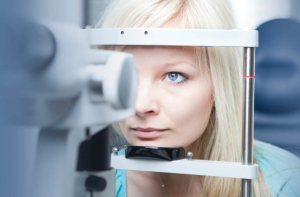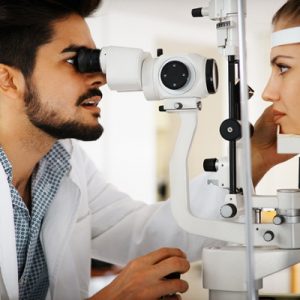How do contact lenses correct vision?
Have you ever thought about how a piece of plastic can improve your vision?
Contact lenses are primarily prescribed by eye doctors to correct vision acuity affected by myopia, hyperopia, astigmatism and presbyopia. When placed on the cornea, contact lenses enable clear vision by allowing light to properly focus on the retina.
Contact lenses are designed to cover the cornea, the clear covering of the eye. They stay in place by adhering to the tear film of the eye, and through the pressure from the eyelids. When you blink, your eyelid glides over the contact lens, enabling a cleansing and lubricating action to keep the contact lens comfortable on the cornea.
Caution: Contact lenses must be fitted properly to your eyes. If they slide around due to improper fit, a serious complication called a corneal ulcer can occur— which can lead to permanent vision loss.
If you suspect you have an eye condition, contact an eye doctor near you, who can diagnose and treat the condition.
SEE RELATED: The Contact Lens Exam
Types of contact lenses
Different types of contact lenses are prescribed to correct a variety of vision conditions:
- Soft contacts: These lenses are the most commonly prescribed type of contact lens. They are known for their comfort and ease of adaptability. These lenses are available in daily, biweekly, and monthly disposables— extended wear options are also available.
- Rigid gas permeable contacts (RGP): These lenses are also known as ‘hard lenses’. They provide clear vision for many complex vision conditions. Their high oxygen permeability decreases the risk of eye infections. These lenses may take a bit longer to adjust to when compared to soft lenses.
- Toric lenses: Used for people with astigmatism, these lenses can be prescribed with a standard design for most common optical powers, or specially customized if required.
- Bifocal/Multifocal contacts: Used for correction of focusing difficulties, or to prevent myopia progression, these lenses contain different lens powers for near and distant vision.
- Ortho-k lenses: Used for myopia management, these lenses are generally worn overnight, and work to reshape the cornea to enable clear vision during the daytime, without the need for eyewear.
- Scleral lenses: Used for patients with an irregular corneal shape, these lenses bridge over the cornea and rest on the white (sclera) of the eye.
What are the advantages and disadvantages of wearing contact lenses?
Advantages:
- Provides clear vision, without eyeglasses
- Increases peripheral vision
- Lowers risk of damaged or lost eyeglasses
- Enhances feeling of ‘natural vision’
- Elevates self-esteem
- Eliminates foggy or rain spotted lenses
- Facilitates easier wear of protective eyewear
- Improves vision for sports:
- Reduced risk of eye injuries
- More stable vision
- Better peripheral vision
Disadvantages:
- Cleaning and disinfecting can be inconvenient
- Good eye-hand coordination is necessary for proper insertion/removal
- Increased risk of eye scratches and infections
- Lenses can fall out, get damaged, or lost during the day
- Blurred vision can result if lens moves too much
- Higher frequency of visits to the eye doctor
- Additional expenses
Why do contact lenses cause eye infections?
Research indicates that most people (ranging from 40-90%) do not take proper precautions to maintain optimal contact lens hygiene.
Contact lens wearers MUST follow careful instructions to maintain optimal hygiene in order to prevent any eye infections.
Consider these statistics:
- Every year, 1 in 500 contact lens wearers contracts a serious vision threatening eye infection.
- Improper contact lens use can cause keratitis— a painful eye infection that affects over 1 million people annually.
How to prevent an eye infection from contact lenses
While it may seem scary to think that wearing contact lenses can cause serious eye infections, keep in mind that you can minimize your risk of developing an infection by taking preventative measures:
- Always wash hands before inserting or removing contact lenses
- Keep fingernails short and clean
- Clean contact lenses and cases as directed by your eye doctor
- Replace contact lenses as directed by your doctor
- Attend all appointments with your eye doctor
When are contact lenses NOT recommended?
While most people adjust to wearing contacts without much difficulty and truly enjoy their benefits, there are some circumstances that may prevent you from adapting easily. If any of the following factors affect you, eyeglasses may be a more appropriate choice for you.
- Eye allergies with severe eye irritation
- Dusty work or living environment
- Chemical exposure on regular basis
- Overactive thyroid
- Uncontrolled diabetes
- Severe arthritis in your wrist/hand
- Chronic dry eyes
While these factors may make it difficult to wear contact lenses on a daily basis, speak to your eye doctor about the possibility of wearing contact lenses on occasion, for special events or activities. Your eye doctor will determine the most appropriate type of contact lenses for your individual needs.
LEARN MORE: Optical and Contact Lenses
There are many benefits to wearing contact lenses. Schedule a comprehensive eye exam today to discover if contact lenses can enhance the way you view life around you.










